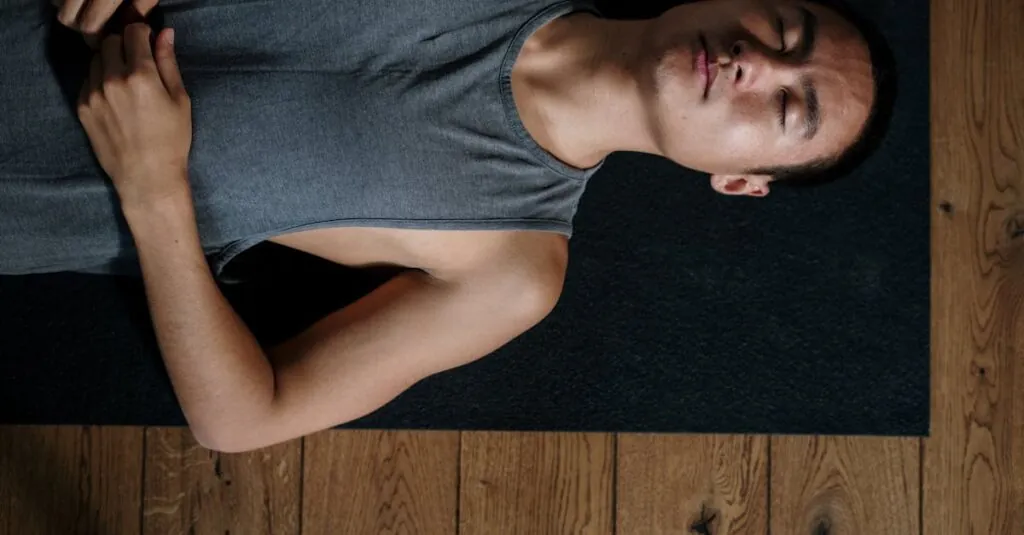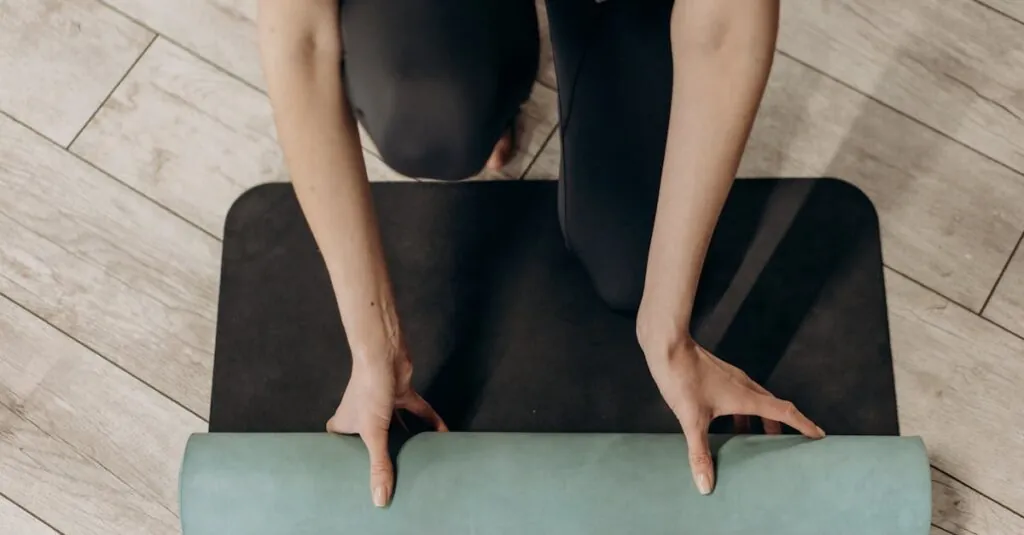In a world buzzing with distractions, finding a moment of peace can feel like searching for a needle in a haystack. But what if meditation didn’t have to be a solemn affair? Imagine transforming your mind into a serene oasis while still chuckling at life’s absurdities. Meditation hacks are here to save the day, turning the daunting into the delightful.
Whether you’re a seasoned yogi or a curious newbie, these clever techniques can help anyone tap into tranquility without the need for incense or a mountain retreat. From quirky breathing exercises to unexpected visualization tricks, these hacks will have you meditating like a pro in no time. So, grab your favorite mug of herbal tea and prepare to unlock the secrets to a more relaxed, joyful you.
Table of Contents
ToggleUnderstanding Meditation Hacks
Meditation hacks simplify the practice, making it accessible and enjoyable. These techniques empower individuals to cultivate mindfulness without feeling overwhelmed.
What Are Meditation Hacks?
Meditation hacks refer to unconventional strategies that enhance the experience of meditation. These methods include engaging techniques like quirky breathing exercises, which can transform a routine practice into an enjoyable activity. Visualization tricks also serve as effective tools, allowing practitioners to imagine serene landscapes or peaceful scenarios, fostering a conducive state for meditation. Adapting the environment with simple changes like soft lighting or calming sounds makes meditation more inviting. They turn traditional meditation into a flexible practice fitting various lifestyles.
Benefits of Using Hacks in Meditation
Using hacks in meditation boosts engagement and commitment to the practice. Individuals often experience enhanced focus, which leads to deeper mindfulness. Creative approaches provide an element of fun, reducing resistance to meditation. Hacks also cater to diverse needs, ensuring that everyone can find a method that resonates. Practitioners may notice improved emotional regulation, as accessible techniques often yield immediate results. Increased comfort in meditation fosters a habit, prompting individuals to integrate mindfulness into daily routines seamlessly.
Simple Meditation Hacks for Beginners
Meditation doesn’t have to be intimidating. These simple hacks make it easier for beginners to incorporate mindfulness without stress.
Time-Saving Techniques
Embrace short sessions. Even five minutes of focused breathing can create a significant impact. Set a timer to cultivate consistency, preventing distractions from extending practice times. Incorporate mindfulness into daily routines, like meditating during commutes or while waiting in lines. Using guided meditation apps, such as Headspace or Calm, can help maintain focus even in brief moments. Remember, it’s about quality, not quantity, so fit meditation into available pockets of time.
Creating a Distraction-Free Zone
Establish a calming environment. Choose a quiet corner at home, equipped with comfortable seating or cushions. Consider soft lighting and pleasant scents to enhance relaxation. Noise-canceling headphones can help block out background sounds, making meditation more immersive. Surrounding oneself with calming visuals, like plants or serene artwork, fosters tranquility. Personalize the space with items that evoke a sense of peace, ensuring it’s inviting for practice.
Advanced Meditation Hacks for Experienced Practitioners
Experienced practitioners can enhance their meditation practices through innovative techniques that integrate modern technology and mindful resources. These advanced hacks offer deeper engagement and personalization, fostering a profound meditation experience.
Incorporating Technology
Utilizing meditation apps can streamline personalized sessions. Apps like Headspace or Calm provide structured programs tailored to specific goals, whether improving focus or reducing anxiety. Incorporating biofeedback devices adds another layer, helping track stress levels and breathing patterns. Smart speakers can play soothing sounds or guided meditations, creating an immersive environment. Virtual reality (VR) also presents unique opportunities, transporting users to serene landscapes, which enhances the overall meditation experience. Engaging with these technologies allows for a tailored approach, adapting to individual preferences or needs, ultimately enriching the practice.
Using Guided Meditations
Exploring guided meditations facilitates deeper exploration of various techniques. Practitioners can choose from diverse topics, such as stress relief, self-compassion, or creativity enhancement. Specific practices, like body scan meditations, encourage awareness of physical sensations and promote relaxation. Collaborating with seasoned meditation teachers through online courses can also provide insights into advanced techniques. Always select guides that resonate personally, ensuring a meaningful connection during sessions. Personalized instructions can deepen one’s practice and cultivate sustained mindfulness, integral to long-term meditation success.
Unique Meditation Hacks from Different Cultures
Meditation techniques vary widely across cultures, offering unique approaches to achieving mindfulness and tranquility. Exploring these diverse practices can enhance one’s own meditation journey.
Mindfulness Practices from Buddhism
Buddhism emphasizes mindfulness as a way to cultivate awareness and presence. Sitting in a comfortable position fosters focus on the breath and bodily sensations. Notably, practitioners utilize the technique of “noting,” where thoughts and distractions are acknowledged without judgment before gently returning attention to the breath. Regular practice of Tonglen, a Tibetan Buddhist technique, encourages compassion by breathing in another’s pain and breathing out relief. Engaging in these practices helps enhance emotional resilience and promotes a deeper connection with one’s thoughts.
Breathing Techniques from Yoga
Yoga introduces various breathing techniques known as pranayama, enhancing meditation experiences. Ujjayi breathing, for instance, involves a slight constriction of the throat, creating an ocean-like sound that aids concentration. Another technique, Nadi Shodhana, balances energy by alternating nasal breathing. Practitioners find that these methods improve focus and calm the mind, allowing for deeper relaxation. Incorporating pranayama into meditation transforms the experience, making it more dynamic and accessible for individuals of all levels.
Popular Meditation Apps and Tools
Meditation apps and tools simplify mindfulness practices for users. These resources offer flexibility and support for various meditation styles and experiences.
Overview of Top Apps
Headspace stands out for its user-friendly interface and diverse guided sessions. Calm boasts a vast library of meditations, sleep stories, and soothing sounds. Insight Timer provides access to thousands of free meditations and community features, fostering connection among users. Simple Habit focuses on short, impactful sessions, perfect for busy schedules. Breethe emphasizes relaxation techniques alongside traditional meditative practices. Each app serves distinct preferences, catering to beginners and experienced practitioners alike.
How to Choose the Right Tool for You
Identifying personal meditation goals will guide app selection. Consider whether stress reduction, increased focus, or sleep improvement is the main priority. Exploring app features is essential for finding the right fit. Check for guided sessions, ambient sounds, or customizable options that resonate with individual preferences. Reading reviews from other users can also provide valuable insights. Ultimately, trial and error with different tools can lead to discovering the most effective meditation app for enhancing the practice.
Embracing meditation hacks can transform the way individuals approach mindfulness. By integrating these playful and innovative techniques into their routines, they can overcome the intimidation often associated with traditional practices.
Whether through quirky breathing exercises or the use of modern apps, the journey toward tranquility becomes more accessible and enjoyable.
As they explore various methods and tools, practitioners can discover what resonates best with them, fostering a sustainable meditation habit that enhances focus and emotional well-being. With the right strategies in place, anyone can cultivate a more mindful and fulfilling life.









